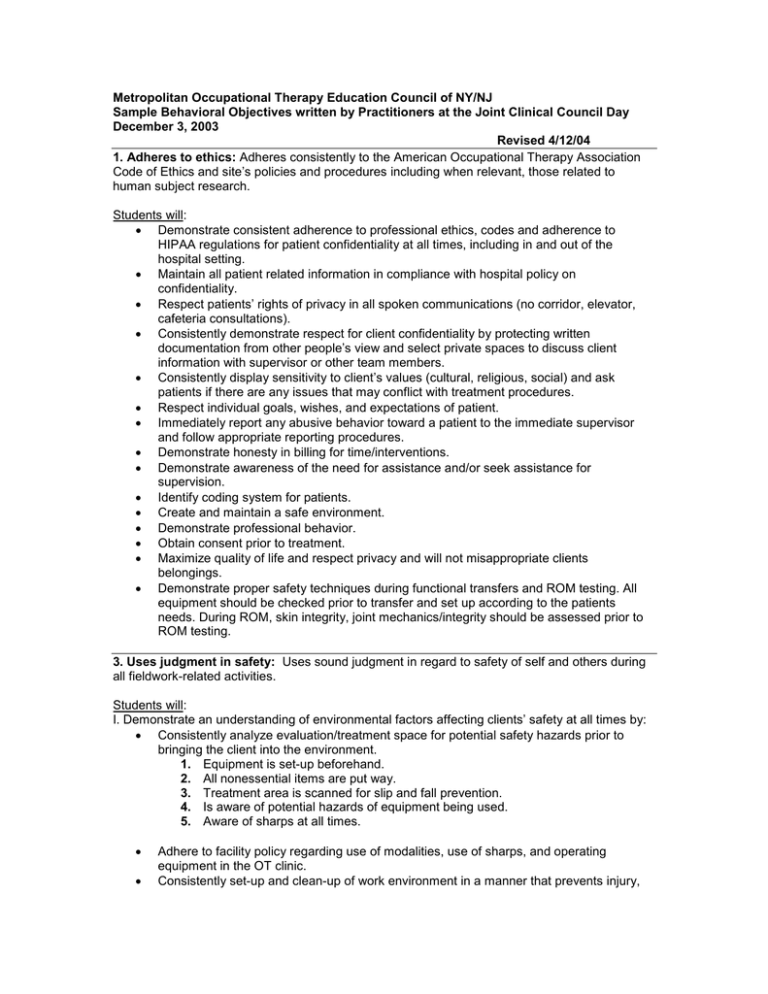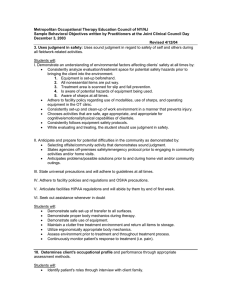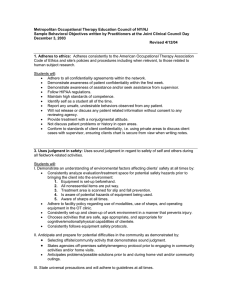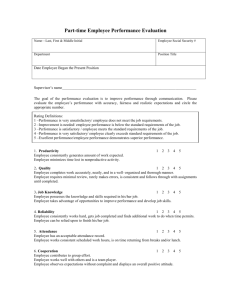Metropolitan Occupational Therapy Education Council of NY/NJ
advertisement

Metropolitan Occupational Therapy Education Council of NY/NJ Sample Behavioral Objectives written by Practitioners at the Joint Clinical Council Day December 3, 2003 Revised 4/12/04 1. Adheres to ethics: Adheres consistently to the American Occupational Therapy Association Code of Ethics and site’s policies and procedures including when relevant, those related to human subject research. Students will: • Demonstrate consistent adherence to professional ethics, codes and adherence to HIPAA regulations for patient confidentiality at all times, including in and out of the hospital setting. • Maintain all patient related information in compliance with hospital policy on confidentiality. • Respect patients’ rights of privacy in all spoken communications (no corridor, elevator, cafeteria consultations). • Consistently demonstrate respect for client confidentiality by protecting written documentation from other people’s view and select private spaces to discuss client information with supervisor or other team members. • Consistently display sensitivity to client’s values (cultural, religious, social) and ask patients if there are any issues that may conflict with treatment procedures. • Respect individual goals, wishes, and expectations of patient. • Immediately report any abusive behavior toward a patient to the immediate supervisor and follow appropriate reporting procedures. • Demonstrate honesty in billing for time/interventions. • Demonstrate awareness of the need for assistance and/or seek assistance for supervision. • Identify coding system for patients. • Create and maintain a safe environment. • Demonstrate professional behavior. • Obtain consent prior to treatment. • Maximize quality of life and respect privacy and will not misappropriate clients belongings. • Demonstrate proper safety techniques during functional transfers and ROM testing. All equipment should be checked prior to transfer and set up according to the patients needs. During ROM, skin integrity, joint mechanics/integrity should be assessed prior to ROM testing. 3. Uses judgment in safety: Uses sound judgment in regard to safety of self and others during all fieldwork-related activities. Students will: I. Demonstrate an understanding of environmental factors affecting clients’ safety at all times by: • Consistently analyze evaluation/treatment space for potential safety hazards prior to bringing the client into the environment. 1. Equipment is set-up beforehand. 2. All nonessential items are put way. 3. Treatment area is scanned for slip and fall prevention. 4. Is aware of potential hazards of equipment being used. 5. Aware of sharps at all times. • • Adhere to facility policy regarding use of modalities, use of sharps, and operating equipment in the OT clinic. Consistently set-up and clean-up of work environment in a manner that prevents injury, • • • Chooses activities that are safe, age appropriate, and appropriate for cognitive/emotional/physical capabilities of clientele. Consistently follows equipment safety protocols. While evaluating and treating, the student should use judgment in safety. II. Anticipate and prepare for potential difficulties in the community as demonstrated by: • Selecting offsite/community activity that demonstrates sound judgment. • States agencies off-premises safety/emergency protocol prior to engaging in community activities and/or home visits. • Anticipates problems/possible solutions prior to and during home visit and/or community outings. III. State universal precautions and will adhere to guidelines at all times. IV. Adhere to facility policies and regulations and OSHA precautions. V. Articulate facilities HIPAA regulations and will abide by them by end of first week. VI. Seek out assistance whenever in doubt. Students will: • Incorporate fall prevention program into all patient treatment plans. • Ask for help during unsafe transfer to any functional surface. • Adheres to safety precaution regarding medical equipment patient-pulse O2, IV, foley catheter, etc. • Monitor vital signs. • Demonstrate sound safety and judgment consistent with all patient contact (i.e. transfers to secure surfaces, ROM treatment, activities, obstacles in environment, physical barriers IV poles, catheters, IV’s, monitoring devices, adherence to MD orders regarding WB status, OOB, ROM, NPO, dressing change and splints). • Ensure client’s safety and comfort at all times especially when specialized equipment is involved (i.e., wheelchairs, computers, walkers). 5. Clearly, confidently, and accurately articulates the value of occupation as a method and desired outcome of occupational therapy to clients, families, significant others, colleagues, service providers, and the public. Students will: • Clearly define the role of OT and relate it to the activity to the patients. • Explain the value of activity chosen with respect to clients own life activities/occupations. • Define the OT process in an effective manner that is understandable to clients, etc. • Explain to client and family, value of returning to roles, responsibilities to a level of audience understanding. 10. Determines client's occupational profile and performance through appropriate assessment methods. Students will: • Obtain a thorough occupational profile through patient's interview, family interview, and review of medical chart documentation. • Obtain clients role in society with the leisure activities initial evaluation. • Students will ask client what areas are important to them. • Interview family when unable to directly interview client about his/her occupational profile. • • • Initiate and integrate patient's occupational profile into patient treatment focus. Investigate client’s goals for self and assess relevant areas to help client achieve those goals. Demonstrate knowledge of age-specific and/or functional level performance/roles in maintaining and implementation of treatment program 12. Obtains sufficient and necessary information from relevant resources such as client, families, significant others, service providers, and records prior to and during the evaluation process. Students will: • Utilize resources to find information. • Perform chart review prior to evaluation and treatment planning. • Be able to determine what extra information will be necessary. 13. Administers assessments in a uniform manner to ensure findings are valid and reliable. Students will: • Consult institution manuals and supervisor prior to the administration of standardized tests. • Understand rationale for performing standardized tests. • Choose appropriate standardized assessment for patient. 14. Adjusts/modifies the assessment procedures based on client’s needs, behaviors, and culture. Students will: • Notice and respond to client feedback to accommodate assessment as needed. 18. Articulates a clear and logical rationale for the intervention process. Students will: • Describe to the client the reason why the task is being performed in a manner that the client understands. • Communicate the use of graded occupation as a means to support participation in BADL/IADL. • Describe purpose of intervention at the client’s level of understanding. • Demonstrate purpose and goals to implement treatment plan and to carry out. 32. Clearly and effectively communicates verbally and nonverbally with clients, families, significant others, colleagues, service providers, and the public. Students will: • Interact, communicate, and share relevant information with all caretakers, families, and health care professionals. • Clearly and effectively communicate verbally by stating clear goals and rationale of treatment to patients, family, and colleagues. • Clearly and effectively communicate with patients, families, and team members to explain possible outcomes of OT. • Give instructions for the treatment process that are effective, clear, concise, and understandable for each patient’s developmental level and learning style. • • • • • • • • • • • Respond appropriately to behaviors and questions, give feedback, appropriate cues, and the appropriate amount of assistance to enable patient to participate in activity. Take into account cultural differences and language barriers (providing handout and information in first language). Communicate/demonstrate effective communication skills to meet the needs of each patient. Demonstrate good observational skills when communicating with patients, adjusting instructions based on patient's reactions. Be aware of nonverbal communication and body language of patients, families, and colleagues. Learn to use and develop therapeutic use of self and maintain rapport with patient. Develop boundaries/ability to set appropriate limits with patients. Provide appropriate validation, support, and feedback to patients as needed. Accept constructive feedback and provide input as part of interpersonal communication. Contribute clear, accurate, and concise reports/feedback in team meetings regarding each patient’s progress. Clearly and effectively write progress reports based upon and related to changes in a patient’s progress and needs. 36. Collaborates with supervisor(s) to maximize the learning experience. Students will: • Be an active part of supervision and feedback. • Take initiative to identify difficulties experienced during evaluation/treatment. • Take initiative to present plan of action to improve performance. • Use feedback provided to come up with strategies/plans for improvement. • Incorporate feedback from supervisor into treatment planning and intervention and discuss outcome. 38. Responds constructively to feedback. Students will: • Notice and respond to feedback in a way that would encourage an open exchange of ideas and develop entry-level skills in an effective way. • “Hear” and act upon constructive feedback from supervisor by making suggestions as to what could have been or needs to be changed. • Demonstrate an active and positive attitude evidenced by body language and use of voice. • Verbalize understanding of feedback and develop effective and measurable goals for improvement as needed. • Give ideas and respond to feedback on ways to improve by giving examples of what they would do in future situations. • Demonstrate change in behavior that shows an understanding of feedback and a movement towards acquiring professional behaviors. • Articulate positive feedback and strengths pointed out by supervisor.



